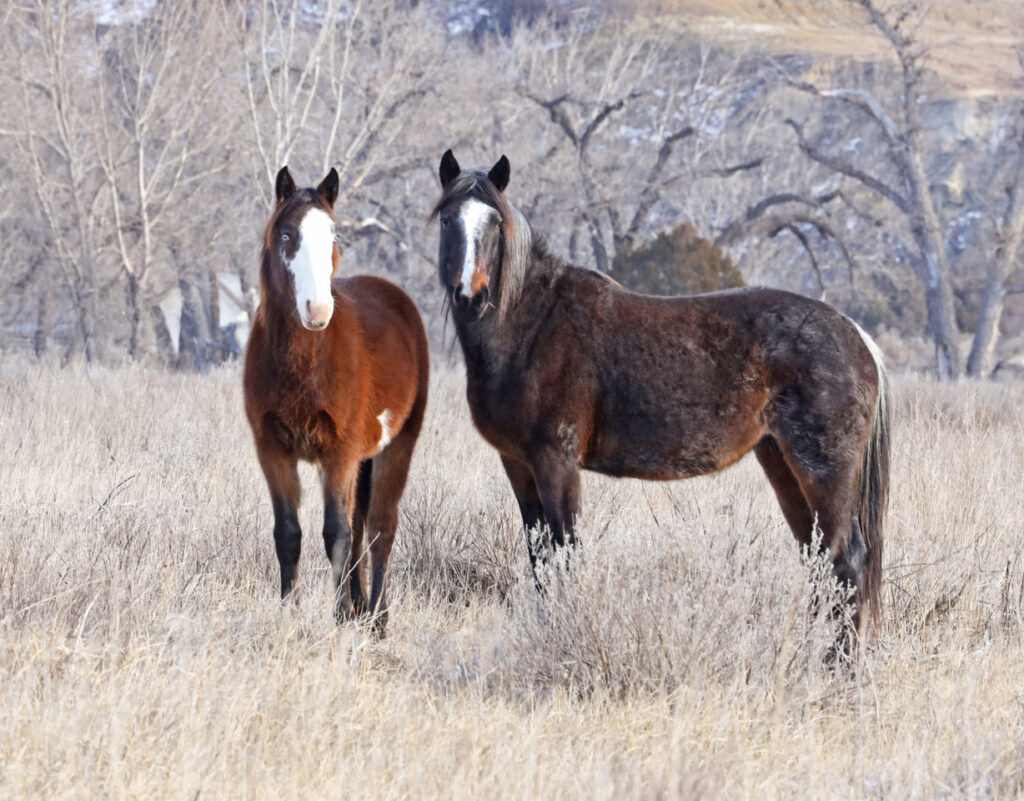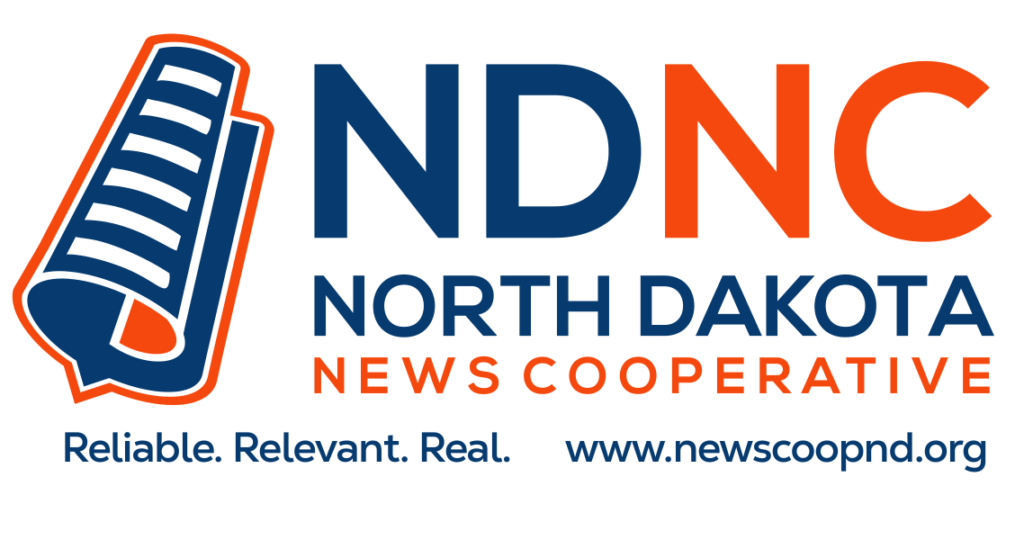Medora businesses, statewide tourism could suffer without wild horses
Though acute for some, overall impacts hard to quantify
Michael Standaert
North Dakota News Cooperative

Horses from the Arrowhead and Flax bands mingle below the crest of a butte, with foal Grizz scampering up toward his mother Little Bear [black, in back] in June, 2023. Photo provided by Christine Kman
These equine influencers go by names like Grizz, Arrowhead, Flax, Little Bear. They’re neither pets, nor livestock, and they roam wild in North Dakota’s only national park.
That may change pending an anticipated 2024 management decision by Theodore Roosevelt National Park staff to remove the nearly 200 horses, or cull to a greatly reduced number.
The decision is being closely watched by many who’ve followed and named the horses on social media posts over the years and by owners of businesses in and around Medora, the gateway town synonymous with the park.
“Everyone has their favorites,” said Christine Kman, owner of a shop called Chasing Horses in Medora. She sells horse- and badlands-themed merchandise, and she and her husband Gary host tours so visitors can see horses, bison and other wildlife in the park.
Kman, like other merchants in Medora, is concerned about the economic impact of the National Park Service’s plans.
While the business would survive the hit if horses were removed or their numbers reduced, they’re “definitely a draw,” she said. On top of the economic impact is one without a price tag. It saddens her and others that horses they’ve come to know and love may soon disappear.

“There were a lot of people who came last year because they were afraid maybe there wouldn’t be any horses after this year,” said Kman, who also co-founded Chasing Horses Wild Horse Advocates, a nonprofit fighting to keep the park’s horses.
Mary Griffin, owner of Medora’s Custer’s Cottage, has a better idea of the impact on her business. She estimates she could lose at least one-fifth of her income if the horses are removed from the park.
“I have customers that come in the spring and the fall, solely because of the horses,” Griffin said. “That’s the only reason they are here. I’m a small lodging business, so I personally visit with people and know why they’re here.”
Hard to quantify
Most businesses, whether in Medora, Dickinson, or Watford City, find it hard to tally income specifically related to the iconic horses. Statewide tourism impacts from the horses are equally tough to parse out. It’s intangible, but it’s also grounded in visitor experience.
“Business owners I’ve spoken to almost always talk about how the customers that come into their businesses talk about the joy of having horses in the park and how much they enjoy seeing them along with the rest of the wildlife,” said Clarence Sitter, current president of the Medora Chamber of Commerce.
“I think as a community, we certainly would like to see the National Park Service do everything they can to keep them,” he said.
Former mayor Doug Ellison, who operates the Amble Inn & Western Edge Books in town, said that over the years Medora has become synonymous with the national park and the park so synonymous with the horses that changing the status quo could be detrimental all around.
“If you take that away, it’s really going to have a negative impact,” he said. Ellison said he continues to hear from people who say they won’t return to the park or visit nearly as often if the horses are removed.
“If they’re gone, a lot of people aren’t going to return, which translates obviously into an economic impact, and that’s a very important part of this,” Ellison said.
Kaelee Wallace is marketing and communications director at the Theodore Roosevelt Medora Foundation which facilitates the Medora Musical and other properties in the area. She said that although it is hard to gauge the economic value of the horses to the community, “their value to the visitor experience is definitely felt every day in our conversations with them.”
What is known is that an average of 700,000 visitors come to the park each year.
Park service data from 2021 estimated that 796,000 visitors spent over $56 million visiting the park, directly supporting at least 675 jobs through tourism in Medora and communities closest to the park. An additional $62 million in economic activity is also generated in nearby communities directly from those visits, either though hotel, restaurant or other activity, the park service estimated.
State Department of Commerce director of tourism, Sara Otte Coleman, said the state has tried to calculate visitor spending directly related to the wild horses but hasn’t come up with good numbers since so many factors are involved in a decision to visit the park.
“We do know that our visitors enjoy the uniqueness of the horses in our national park and it improves their experience,” she said. “That said, it also is the sole motivator for some, we just can’t measure that efficiently.”
According to the park service, nearly 90 percent of park visitors surveyed from 2016 to 2018 supported maintaining wild horses at the South Unit. The North Unit is a separate section of the park and does not host horses.
An environmental assessment released by the park in September outlining options for maintaining, reducing or removing the horses, incorrectly stated that only 49 percent of those surveyed favored maintaining the herd but was citing the same survey.
That assessment stated that “the phased removal of horses from the South Unit would have little to no incremental impact on regional economic conditions given the other visitor opportunities available at the Park.”
Superintendent of the park Angie Richman declined an interview for this story, but did comment that park staff are reviewing comments from the public received last November, and will be producing a comment analysis report after the review.
“We are also separately and concurrently assessing the applicability of Section 106 of the National Historic Preservation Act,” Richman said in an e-mailed response, adding that decisions will not be made until all those processes are complete.
Last April, North Dakota legislators passed a resolution urging the Secretary of the Interior and the director of the NPS to modify its plan related to the removal and “continue to allow for interpretative, cultural, and historical purposes” both the wild horse herds in the South Unit and of longhorn steers in the North Unit.
Higher powers
Besides potentially utilizing the National Historic Preservation Act, the possibility of emulating actions at other federally administered lands with wild horses surfaced repeatedly in interviews. Examples are protections placed on herds on coastal islands in Maryland and North Carolina.
“I’m thinking that unless Congress gets involved with the National Park Service’s plan, the park service will do what they decide they want to do,” Griffin of Custer’s Cottage said. “I think it’s going to take those higher powers to enter into the conversation.”
According to a statement from the office of U.S. Sen. John Hoeven, R-ND, discussions with the park service about maintaining the horses at the park are ongoing.
With Department of Interior funding extended through Feb. 2, and fiscal year funding underway, “We are working to ensure the appropriations legislation passed by Congress includes our measure calling on Interior to keep wild horses in the park,” said Hoeven’s spokesman Alex Finken in a statement.
Spokesman Mike Nowatzki said that Gov. Doug Burgum has made it clear that he is willing to support the park’s horse management program if necessary. Relocating the horses is not a viable option since the horses are such a draw for visitors to the park, and the office is in ongoing discussions with the park superintendent about specific areas of support, Nowatzki said.
“We agree that the economic impact of the wild horses to the region is hard to quantify. However, based on the tremendous outpouring of support from across the nation for keeping the horses, it’s clear that they are a significant attraction and play an important role in generating economic activity for Medora and the surrounding area,” Nowatzki said.

The North Dakota News Cooperative is a non-profit news organization providing reliable and independent reporting on issues and events that impact the lives of North Dakotans. The organization increases the public’s access to quality journalism and advances news literacy across the state. For more information about NDNC or to make a charitable contribution, please visit newscoopnd.org.


The North Dakota News Cooperative is a new nonprofit providing real journalism about North Dakotans for North Dakotans. To support local journalism, make your charitable contribution to www.newscoopnd.org.






